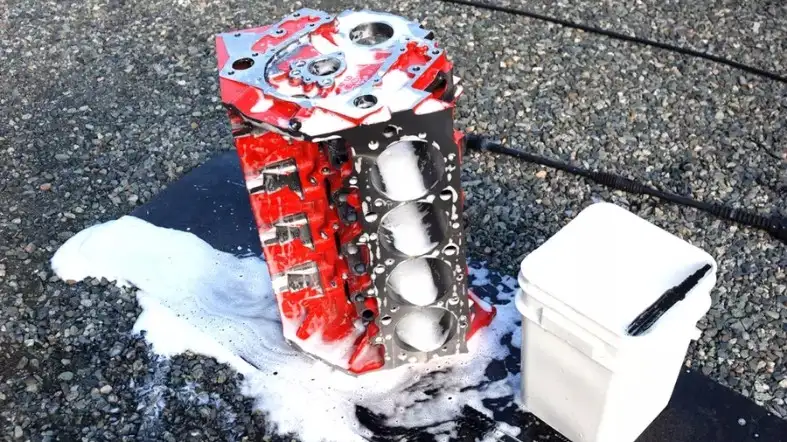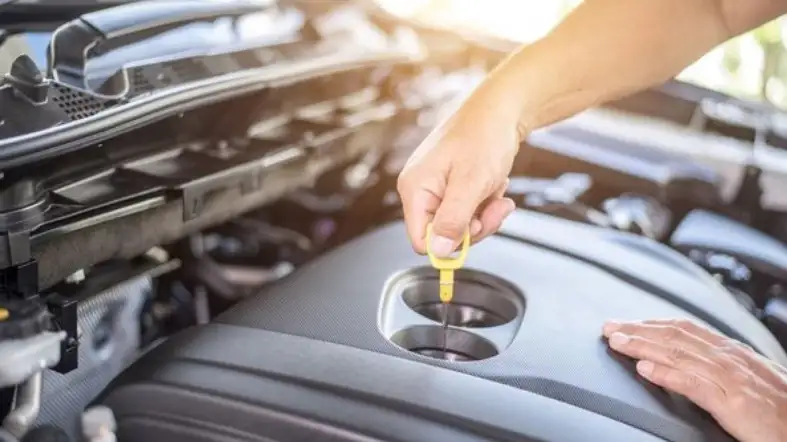Cleaning your engine block before assembly is a crucial step in ensuring peak performance for your vehicle.
The engine block is the heart of your car, and a clean one can significantly impact its efficiency.
In this comprehensive guide, we will walk you through the entire process, from removing all removable components to dealing with different contaminants effectively.

How To Clean Engine Block Before Assembly?
Here is a detailed guide to effectively cleaning your engine block before assembly
Remove All Removable Components
Check if the engine is cold to the touch. Be careful not to burn yourself! Lift up the hood and remove all removable components; such as air filters and hoses.
Make a point to gently pull out or remove the screw or unplug. Store all the screws and small parts securely. These will be necessary when packing everything back.
Pre-Clean Using Wire Brush.
Don a pair of protective gloves and pick up a wire brush. Rub off the loose dirt, grime, and oil spots gently from the engine block.
It simplifies the core cleaning stage. Don’t press too hard. Do not damage the metal surface.
Use Cleaning Solvent
Then, purchase a cleaning solvent designed for engine blocks. Remember to read the label for any special instructions.
Use the solvent liberally, but do not let it pool. The latter is better because it should be applied uniformly in all areas. This breaks down stubborn dirt.
Scrub the Surface
And, now, take a medium-bristle scrub brush. Work it into all the nooks and crannies.
Particularly the areas with extra grease or soiled spots. Break it down through circumrotation.
Rinse with Water
Rinse after scrubbing. For this, you use a garden hose with a spray nozzle. Get all the corners.
Wash off all the solvents and loosen the grime. When you’re finished, the water should run clear. There should not be any stuffiness in the stuff.
Dry Using an Air Compressor
Rust may develop when water is left on the engine block. That’s bad news. Dry off the engine block completely using an air compressor.
Sweep the nozzle of the compressor air over the engine. Make sure it’s entirely dry. Later, a little water can become a problem.
Final Inspection
Finally, it’s time for the last check. Look over the engine block. See if you missed any spots. If you did, it’s okay to go back and clean those areas.
Also, check for any damage you might have caused. Make sure everything looks good before you start putting the removable components back.

Types of Contaminants You’ll Remove
Dirt and Dust
When it comes to cleaning, dirt and dust are common foes. These tiny particles can settle on surfaces, making them look dirty.
Dirt often comes from outdoor sources like soil, while dust consists of tiny, floating particles like dead skin cells and pollen.
You’ll need to wipe or vacuum them away to keep things clean.
Oil and Grease
Oil and grease can be tricky to deal with. They often show up in places like kitchens and garages.
Oil can come from cooking, while grease might be from machinery. To remove them, use special cleaners or dish soap mixed with water.
Scrub the affected area gently until the oil and grease are gone.
Rust
Rust is the reddish-brown stuff that forms on metal when it gets wet and exposed to air.
It’s like metal’s way of saying, “I need help!” To remove rust, you’ll need a rust remover or a mixture of vinegar and baking soda.
Scrub it away with a brush until the metal shines again.
Paint Residue
Dealing with paint residue is essential when you’re trying to refresh a surface.
Whether it’s old paint drips or spatters, removing them can make your project look brand new.
Use a putty knife or scraper to gently lift the paint residue from the surface. Be careful not to scratch the underlying material.
Now that you know the types of contaminants you might encounter, let’s dive into how to tackle them effectively.
Safety Precautions When Cleaning an Engine Block
It’s crucial to follow safety precautions to protect yourself and the environment. Here are some detailed steps to ensure your safety:
Wear Safety Goggles and Gloves
When cleaning an engine block, always put on safety goggles to shield your eyes from potential splashes of cleaning solvents or debris.
Additionally, wear protective gloves to safeguard your hands from chemicals and sharp edges.
Work in a Well-Ventilated Area
Choose a workspace that has proper ventilation. Cleaning solvents emit fumes that can be harmful when inhaled.
Adequate ventilation helps disperse these fumes and maintain a healthier working environment.
Dispose of Cleaning Solvents Properly
After cleaning, it’s essential to dispose of cleaning solvents in an environmentally friendly manner.
Do not pour them down the drain or on the ground. Instead, follow local regulations for hazardous waste disposal.
This helps protect the environment and prevents pollution.
Avoid Flammable Materials
During the cleaning process, steer clear of flammable materials.
Keep items like paper towels, rags, or cleaning cloths away from the work area. Cleaning solvents can be highly flammable, so it’s crucial to minimize fire hazards.
By following these detailed safety precautions, you’ll ensure a safer engine block cleaning process.
Always prioritize safety to prevent accidents and protect yourself and the environment.
Common Mistakes to Avoid When Cleaning Engine Block Before Assembly
Using the Wrong Solvent
Proper selection of the solvent is very important in dealing with the hard cleaning processes. If a solvent is wrong, surfaces are damaged, and cleaning is difficult.
Do not make such mistake, read the labels of the product carefully. Does the solvent suit the material you are cleaning?
You should never use harsh chemicals on delicate fabrics as they can lead to staining and weaken fibers.
Try something small and inconspicuous first when in doubt. This helps ensure the solvent does not damage the surface you are cleaning.
Rushing the Process
Cleaning is not a race. If one does that it would turn out to be futile. The error can be prevented by allotting enough time for the task.
The very first step is to get rid of loose dirt and debris before you apply any cleaning products.
Let the solvent soak for the specified time, which helps dissolve stains and dirt.
If you rush, it may happen that you will not see spots and will not give the cleaner the time he or she needs to work. After all, patience produces a cleaner outcome.
Not Taking Safety Precautions
However, you should always bear in mind that safety is the first thing when dealing with cleaners. Neglect of safety precautions is one big mistake.
Always wear protective things like gloves and goggles so as to protect your skin and eyes.
Be sure to ventilate the area to avoid inhaling vapors. Children and pet-friendly. Do not take cleaning products.
Never mix different cleaners unless the label says it’s safe. Mixing certain chemicals can be dangerous. Cleaning, safety is the number one rule.
Forgetting to Rinse Properly
Another mistake is leaving surfaces wet. Poor drying may result into water spots or mould and mildews on fabrics.
Cleaned and rinsed surface should be wiped down with a dry clean cloth or towel. Be sure it’s completely dry before use or storage.
Ventilation facilitates the accelerated drying process. To avoid the musty smell, hang fabrics in a well-ventilated place. The final touch to a truly clean result is adequate drying.
Inadequate Drying
Another mistake is leaving surfaces wet. Insufficient drying can result in water spots or, in the case of fabrics, growth of mold and mildew.
After washing and rinsing, use a clean, dry cloth or towel to wipe the surface. It should be entirely dry for use or storage.
This can also hasten the drying process. Hang fabrics in a well-ventilated area to avoid musty odors. To obtain a really clean result proper drying is the last stage.
Additional Tips for Effective Cleaning
Soak the Block for Stubborn Stains
You need to soak the area where the stubborn stains are to deal with them.
It loosens the dirt that may have settled over time. Soak the item in warm, soapy water in a container for a while.
Warm water and soap will break down the stains, and they will be easier to remove.
Use a Soft Brush for Sensitive Areas
Timing is essential when cleaning. You may not even clean thoroughly because of the speed. Allow the soap or cleaning solution to do its work.
Patience will be your friend here as the cleaning agents need a few minutes to work effectively by breking down dirt and stains.
Timing and Patience
Timing is essential when cleaning. The cleaning may not be done completely. Let the soap do its job.
Your friend is patience here; allow the cleaning agents some minutes to break down dirt and stains effectively for efficient cleaning.
Inspect Thoroughly Before Assembly
Prior to putting any of your item back together, make sure you are through and through with its inspection.
Clean and dry down all the parts. It should be ensured that no stains or dirt were left out.
Finally, reassemble your item, making sure there is one last opportunity to ensure that your item is absolutely sparkling clean.
FAQ
Can I Pressure Wash the Engine Block?
Yes, you can pressure wash the engine block, but precautions are needed to protect other mechanical parts. Use a plastic bag or similar cover to shield other components from high-pressure water.
Is Hot Tanking an Engine Block Necessary?
Hot tanking is used when heavy dirt and contaminants cannot be removed by normal cleaning methods. It involves cleaning the engine block with high-temperature water flow.
Does Steam Cleaning Damage the Engine?
Steam cleaning can be beneficial if done by a specialist, as it helps maintain the engine’s condition. However, if you lack expertise, it’s better to avoid steam cleaning to prevent potential damage.
Can I Use Dish Soap to Remove Oil and Grease?
Yes, you can use dish soap mixed with water to remove oil and grease from the engine block. It’s an effective and readily available cleaning solution.
Are Paint Residue Removers Safe for All Surfaces?
No, paint residue removers should be used with caution. They can damage underlying materials. Always test in an inconspicuous area first to ensure they won’t harm the surface you’re cleaning.
Conclusion
Finally, in order for your automobile to perform at its best, it is important to clean your engine block prior to assembling it.
The first step is disassembly, where movable components are taken off from the equipment. The remaining sections explain how to handle different types of pollutants encountered in the cleaning process.
Do remember to put safety first, use suitable solvents, not to hurry, and inspect the cleaned block well before assembly.
You can keep the essence of your car’s performance intact by paying attention to details and having patience.
